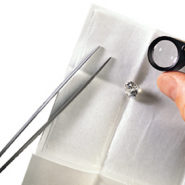Part 1 – An Industry without Standards or Formal Education
Though diamonds and other gemstones have been collected and coveted for many centuries, it has taken almost as long for diamond cutters and jewelers to learn how to reveal a gemstone’s inner beauty.
As early as the 1300s, European stone cutters were changing crystals by polishing their faces so that no natural irregularities of the original crystal remained. While this type of polishing and cutting did allow light to reflect off the outer surface, the fire and brilliance remained hidden inside. Small changes introduced over the next few centuries made diamonds more interesting, but still hid the potential of diamonds to return light as we know it today.
Read More >>Perhaps a special piece of diamond jewelry has been passed down to you. It may be a ring or a pendant set with a beautiful gem. Because this item did not come from a jeweler or gemologist, you really have no way of knowing anything about the diamond’s color, clarity, cut or carat weight – those factors that determine quality, and help you decide whether the diamond is worth resetting or leaving it as it came.
Read More >>While GIA can’t recommend an individual appraiser, there are several appraisal associations and networks that can help you locate one in your area. These are national associations that have members all over the country, and many require that their appraisers have a Graduate Gemologist (G.G.) diploma from GIA in addition to supplemental appraisal training.
Read More >>There are two diplomas issues by GIA. Created in 1931, the prestigious GIA Graduate Gemologist (G.G.) diploma teaches jewelers the science and technical knowledge needed to deal with the entire spectrum of diamonds and colored stones. The distinguished G.G. designation at the end of an individual’s name is instantly recognized around the world as the mark of a senior professional in the jewelry industry.
Read More >>Sometimes the search for the perfect diamond grows into something deeper—a lasting interest in the jewelry and gems. If that’s happened to you, discover how GIA can guide your path toward a Graduate Gemologist (G.G.) or Accredited Jewelry Professional (A.J.P.) diploma, courses in gemology and jewelry arts, and a career in the industry.
Read More >>

